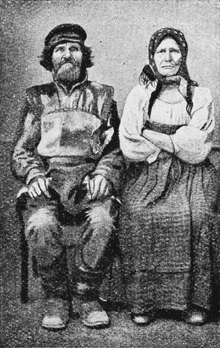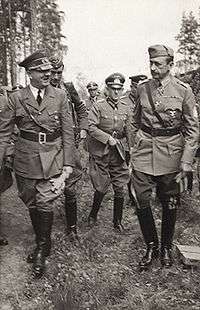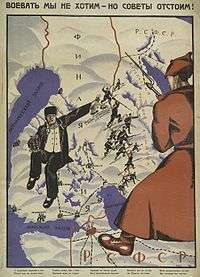Greater Finland

Greater Finland (Finnish: Suur-Suomi; Swedish: Storfinland) is an irredentist and nationalist idea that emphasized territorial expansion of Finland. The most common conception of Greater Finland was defined by natural borders encompassing the territories inhabited by Finns and Karelians, ranging from the White Sea to Lake Onega and along the Svir River and Neva River—or, more modestly, the Sestra River—to the Gulf of Finland. Some proponents also included the Kola Peninsula (as part of a natural border), Finnmark (in Norway), Torne Valley (in Sweden), Ingria (around present-day Saint Petersburg), and Estonia.
The idea of Greater Finland gained popularity and influence rapidly in 1917, but lost support after World War II and the Continuation War.
History
Natural borders
The idea of the so-called three-isthmus border—defined by the White Isthmus, the Olonets Isthmus, and the Karelian Isthmus—is hundreds of years old, dating back to the period when Finland was part of Sweden. There was a disagreement between Sweden and Russia as to where the border between the two countries should be. The Swedish government considered a three-isthmus border to be the easiest to defend.
Although the term "Greater Finland" was not used in the early 19th century, the idea of Finland's natural geographical boundaries dates back to then. In 1837, the botanist Johan Ernst Adhemar Wirzén defined Finland's wild plant distribution area as the eastern border lines of the White Sea, Lake Onega, and the River Svir. The geologist Wilhelm Ramsay defined the bedrock concept of Fenno-Scandinavia at the beginning of the 19th century.

Karelianism
Karelianism was a national romantic hobby for artists, writers, and composers in which Karelian and Karelian-Finnish culture was used as a source of inspiration. Karelianism was most popular in the 1890s. For example, the author Ilmari Kianto, known as the "White friend", wrote about his travels to White Karelia in the 1918 book "Finland at Its Largest: For the Liberation of White Karelia".
Other Nordic countries
The Kvens, a minority in Northern Norway, helped Finnish settlements spread, especially in the 1860s. The Academic Karelia Society and the Finnish Heritage Association worked actively with the Kvens from 1927–1934, and the Finnish media spread pan-Fennicist propaganda through various channels. Activity slowed down from 1931–1934.
In the early days of its independence, Finland wanted Finnish-speaking areas in Norrbotten, Sweden, to join Finland. This was a reaction to the effort by Finland's own Åland Islands to join Sweden. The Finnish government set up a committee to expand Finnish national movements. Sweden, for its part, pushed for instruction in the Swedish language in its northern Finnish regions. In the 1950s, schools there were punished for using the Finnish language.
Heimosodat
The Greater Finland ideology gained strength from 1918–1920, during the Heimosodat, with the goal of combining all Finnic peoples into a single state. Similar ideas also spread in western East Karelia. Two Russian municipalities, Repola and Porajärvi, wanted to become part of Finland but could not under the strict conditions of the Treaty of Tartu. They declared themselves independent in 1919, but the border change was never officially confirmed, mainly because of the treaty, which was negotiated the following year. In the Treaty of Tartu negotiations in 1920, Finland demanded more of Eastern Karelia. Russia agreed to this but kept Repola and Porajärvi for itself, offering Finland Petsamo instead. President Kaarlo Juho Ståhlberg of Finland agreed to the exchange.
Karelians in Uhtua (now Kalevala, Russia) wanted their own state, so they created the Republic of Uhtua. Ingrian Finns also created their own state, North Ingria, but with the intention of being incorporated into Finland. Both states ceased to exist in 1920.
The Greater Finland ideology inspired the Academic Karelia Society, the Lapua movement, and that movement's successor, the Patriotic People's Movement. The Mannerheim Sword Scabbard Declarations in 1918 and 1941 increased enthusiasm for the idea. The modern National Coalition Party and Centre Party remain supporters of it.
1920s and 1930s

Under the Treaty of Tartu, the Soviet Union agreed to give Eastern Karelia (known simply as Karelia with the Soviet Union) political autonomy as a concession to Finnish sentiment. This was in line with the Bolshevik leadership's policy at the time of offering political autonomy to each of the national minorities within the new Soviet state. At the same time, the League of Nations solved the Åland crisis in Finland's favor.
After the Finnish Civil War in 1918, the Red Guards fled to Russia and rose to a leading position in Eastern Karelia. Led by Edvard Gylling, they helped establish the Karelian Workers' Commune. The Reds were also assigned to act as a bridgehead in the Finnish revolution. Finnish politicians in Karelia strengthened their base in 1923 with the establishment of the Karelian ASSR. Finnish nationalists helped some Karelians who were unhappy with the failure of the Karelian independence movement to organize an uprising, but it was unsuccessful, and a small number of Karelians fled to Finland.
After the civil war, a large number of left-wing Finnish refugees fled for the Karelian ASSR. These Finns—an urbanized, educated, and Bolshevik elite—tended to monopolize leadership positions within the new republic. The "Finnishness" of the area was enhanced by some migration of Ingrian Finns, and by the Great Depression. Gylling encouraged Finns in North America to flee to the Karelian ASSR, which was held up as a beacon of enlightened Soviet national policy and economic development.
Even by 1926, 96.6% of the population of the Karelian ASSR spoke Karelian as their mother tongue. No unified Karelian literary language existed, and the prospect of creating one was considered problematic because of the language's many dialects. The local Finnish leadership had a dim view of the potential of Karelian as a literary language and did not try to develop it. Gylling and the Red Finns may have considered Karelian to be a mere dialect of Finnish. They may also have hoped that, through the adoption of Finnish, they could unify Karelians and Finns into one Finnic people. All education of Karelians was conducted in Finnish, and all publications became Finnish (with the exception of some in Russian).
By contrast, the Karelians of Tver Oblast, who had gained a measure of political autonomy independent of Finnish influence, were able by 1931 to develop a literary Karelian based on the Latin alphabet. These Tver Karelians became hostile to what they saw as Finnish dominance of Karelia, as did some of the small, local Karelian intelligentsia. Reactions to the use of Finnish among the Karelians themselves were diverse. Some had difficulty understanding written Finnish. There was outright resistance to the language from residents of Olonets Karelia, while White Karelians had a more positive attitude toward it.
In the summer of 1930, "Finnification politics" became politically sensitive. The Leningrad party apparatus (the powerful southern neighbor of the Karelian Red Finns) began to protest Finnish chauvinism toward the Karelians in concert with the Tver Karelians. This coincided with increasing centralization under Joseph Stalin and the concurrent decline in power of many local minority elites. Gylling and Kustaa Rovio tried to expand the usage of Karelian in certain spheres, but this process was hardly begun before they were deposed. The academic Dmitri Bubrikh then developed a literary Karelian based on the Cyrillic alphabet, borrowing heavily from Russian.
The Central Committee of the Council of Nationalities and the Soviet Academy of Sciences protested the forced Finnification of Soviet Karelia. Bubrikh's Karelian language was adopted from 1937–39, and Finnish was repressed. But the new language, based on an unfamiliar alphabet and with extensive usage of Russian vocabulary and grammar, was difficult for many Karelians to comprehend. By 1939, Bubrikh himself had been repressed, and all forms of Karelian were dropped in both the Karelian ASSR and Tver Oblast (where the Karelian National District was dissolved entirely).
The Great Purge
In Stalin's Great Purge in 1937, the remaining Red Finns in Soviet Karelia were accused of Trotskyist-bourgeois nationalism and purged entirely from the leadership of the Karelian ASSR. Almost all Finns in the area were shot or removed to other parts of the Soviet Union. During this period, no official usage of Karelian was pursued, and Finnish was relegated to an extremely marginal role, making Russian the de facto official language of the republic. By this time, the economic development of the area had also attracted a growing number of internal migrants from other areas of the Soviet Union, who steadily diluted the "national" character of the Karelian ASSR.
The Karelo-Finnish Soviet Socialist Republic (KFSSR) was founded by the Soviet Union at the beginning of the Winter War, and was led by the Terijoki government and Otto Wille Kuusinen. This new entity was created with an eye to absorbing a defeated Finland into one greater Finnic (and Soviet) state, and so the official language returned to Finnish. However, the Soviet military was unable to completely defeat Finland, and this idea came to nothing. Despite this, the KFSSR was maintained as a full union republic (on a par with Ukraine or Kazakhstan, for example) until the end of the Stalinist period, and Finnish was at least nominally an official language until 1956. The territory Finland was forced to cede under the Moscow Peace Treaty was incorporated partly into the KFSSR, but also into Leningrad Oblast to the south and Murmansk Oblast to the north.
During the Continuation War from 1941–1944, about 62,000 Ingrian Finns escaped to Finland from German-occupied areas, of whom 55,000 were returned to the Soviet Union and expelled to Siberia. Starting in the 1950s and 1960s, they were permitted to settle within the KFSSR, although not in Ingria itself.[1]
The Continuation War
During the civil war in 1918, when the military leader Carl Gustaf Emil Mannerheim was in Antrea, he issued one of his famous Sword Scabbard Declarations, in which he said that he would not "sheath my sword before law and order reigns in the land, before all fortresses are in our hands, before the last soldier of Lenin is driven not only away from Finland, but from White Karelia as well".[2] During the Continuation War, Mannerheim gave the second Sword Scabbard Declaration. In it, he mentioned "the Great Finland", which brought negative attention in political circles.
During the Continuation War, Finland occupied the most comprehensive area in its history. Many people elsewhere, as well as Finland's right-wing politicians, wanted to annex East Karelia to Finland. The grounds were not only ideological and political, but also military, as the so-called three-isthmus line was considered easier to defend.
Russians and Karelians were treated differently in Finland, and the ethnic background of the country's Russian-speaking minority was studied to determine which of them were Karelian (i.e., "the national minority") and which were mostly Russian (i.e., "the un-national minority"). The Russian minority were taken to concentration camps so that they would be easier to move away.
In 1941, the government published a German edition of Finnlands Lebensraum, a book supporting the idea of Greater Finland, with the intention of annexing Eastern Karelia and Ingria.

Finland's eastern question
During the Continuation War's attack phase in 1941, when the Finns hoped for a German victory over the Soviet Union, Finland began to consider what areas it could get in a possible peace treaty with the Soviets. The German objective was to take over the Arkhangelsk–Astrakhan line, which would have allowed Finland to expand to the east. A 1941 book by a professor, Jalmari Jaakkola, titled Die Ostfrage Finnlands, sought to justify the occupation of East Karelia. The book was translated into English, Finnish, and French, and received heavy criticism from Sweden and the United States.
The Finnish Ministry of Education established the Scientific Committee of East Karelia on 11 December 1941 to guide research in East Karelia. The first chairman of the commission was the rector of the University of Helsinki, Kaarlo Linkola, and the second chairman was Väinö Auer. Jurists worked to prepare international legal arguments for why Finland should get East Karelia.
Concentration camps

In the conquered territory, internment centers were established. They were first called concentration camps, and later "transfer camps". The people transferred there were:
- Non-Finns from the area who expressed a political view on Finland's military action;
- People deemed "politically unreliable";
- "Other peoples of the population that felt freedom in the militarily governed area would not be considered acceptable."
People of the Zaonezhye Peninsula (by Lake Onega), the Svir Valley, and the Onega isthmus, who traditionally spoke Russian, were transferred to camps further from the front line to prevent Soviet Partisan attacks against civilians. Nevertheless, the Zaonezhye Peninsula was packed with refugee families of non-Finnish origins from various parts of the KFSSR, who waited in vain to be transported over Lake Onega but were caught by the Finnish Defense Forces instead. Up to 16,600 evacuees or refugees who lived near the battlefronts were placed in the concentration camps. Non-Finns accounted for the highest proportion: more than 69 percent of those in the camps, who numbered 23,984 by 1 April 1942.
Death in the camps (37.5%) was significantly higher than in the unoccupied region (26%), let alone in Finland (13.1%). The biggest cause of mortality in the camps seems to have been poor nutrition, and to some extent the population's age distribution: 20- to 30-year-old women and minor children were almost 50%.
The idea's end
The "golden age" of the Greater Finland idea was the 1910s. Its popularity declined in the 1920s but rose for a moment during the Continuation War. After the war, the idea virtually disappeared, because its goals were no longer possible by political or military condition. The Soviet Union had won the war and Finland was prepared for harsh peace treaties, which, among other things, further decreased Finnish territory. In addition to Nazism and fascism, Lebensraum-like expansionism was no longer considered a good thing. The Academic Karelia Society and the Patriotic People's Movement, which favored the Greater Finland ideology, were shut down.
The cultural foundation also fell from the ideology, while communication with the Uralic peoples left under Soviet rule became increasingly difficult and more bureaucratic. In 1991, when Estonia regained its independence with the dissolution of the Soviet Union, it created more opportunities for NGOs and private citizens.
Motivations
The motives of the Greater Finland idea are a subject of disagreement. Some supported the idea out of a desire for wider cultural cooperation. Later, however, the ideology gained clearer imperialist characteristics. The main supporter of the idea, the Academic Karelia Society, was born as a cultural organization, but in its second year, it released a program that dealt with broader strategic, geographical, historical, and political arguments for Greater Finland.
The idea today
Today, the Greater Finland ideology is practiced by few people. It seeks primarily to promote recovery work and the survival of Uralic peoples, without changes in national borders. Such ideas are promoted by the Juminkeko Foundation, the Matthias Castrén Society, and the Finland-Russia Society (Association Finlande-Russie). Among students, the ideology is strongest at the University of Tartu in Estonia.
In August 2008, tensions intensified in South Ossetia, leading to a five-day war. The Keskisuomalainen magazine columnist Kunto Kalpa harshly criticized Finnish-Russian policy, arguing that the Finns had raised their eyes to a "spiritual Greater Finnish idea".[5]
See also
References
- ↑ http://www.inkeri.com/historia.html
- ↑ heninen.net's translation of the first Sword Scabbard Declaration.
- ↑ Geust, Carl-Fredrik (2007). "Murjottavat ja nauravat Äänislinnan lapset" [Sulking and laughing children of Petrozavodsk]. Sotilasaikakauslehti (11): 44–45.
- ↑ (Russian) Семейный Ковчег: "Военное детство нынче не в цене", April 2004
- ↑ Kohunimimerkki Kalpa: Tämä tie voi viedä sotaan – Keskisuomalainen, 29 August 2008
Sources
| Wikimedia Commons has media related to Greater Finland. |
- Manninen, Ohto (1980). Suur-Suomen ääriviivat: Kysymys tulevaisuudesta ja turvallisuudesta Suomen Saksan-politiikassa 1941. Helsinki: Kirjayhtymä. ISBN 951-26-1735-8.
- Nygård, Toivo (1978). Suur-Suomi vai lähiheimolaisten auttaminen: Aatteellinen heimotyö itsenäisessä Suomessa. Helsinki: Otava. ISBN 951-1-04963-1.
- Tarkka, Jukka (1987). Ei Stalin eikä Hitler - Suomen turvallisuuspolitiikka toisen maailmansodan aikana. Helsinki: Otava. ISBN 951-1-09751-2.
- Seppälä, Helge (1989). Suomi miehittäjänä 1941-1944. Helsinki: SN-kirjat. ISBN 951-615-709-2.
- Morozov, K.A. (1975). Karjala Toisen Maailmansodan aikana 1941-1945. Petrozavodsk.
- Jaakkola, Jalmari (1942). Die Ostfrage Finnlands. WSOY.
- Näre, Sari; Kirves, Jenni (2014). Luvattu maa: Suur-Suomen unelma ja unohdus. Helsinki: Johnny Kniga. ISBN 978-951-0-40295-5.
- Trifonova, Anastassija. Suur-Suomen aate ja Itä-Karjala. University of Tartu. , Itämerensuomalaisten kielten laitos. Web version (PDF)
- Solomeštš, Ilja. Ulkoinen uhka keskustan ja periferian suhteissa: Karjalan kysymys pohjoismaisessa vertailussa 1860-1940, Carelia, nro 10-1998, ss.117–119. Web version
- Ryymin, Teemu (1998). Finske nasjonalisters og norske myndigheters kvenpolitikk i mellomkrigstiden. Universitetet i Bergen. Web version
- Olsson, Claes. Suur-Suomen muisto. Web version
- Sundqvist, Janne. Suur-Suomi olisi onnistunut vain natsi-Saksan avulla. Web version. Yle uutiset 26.5.2014.
